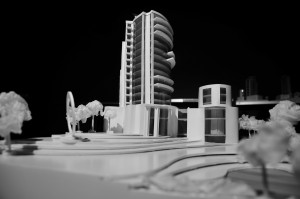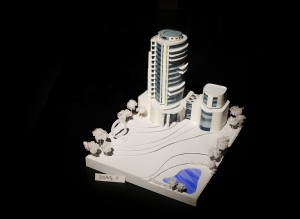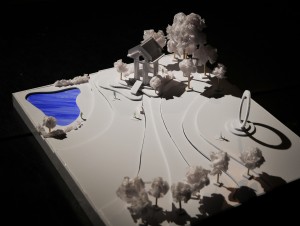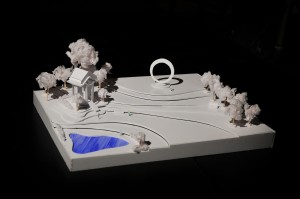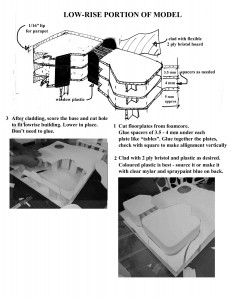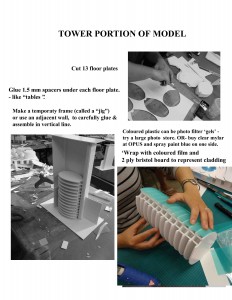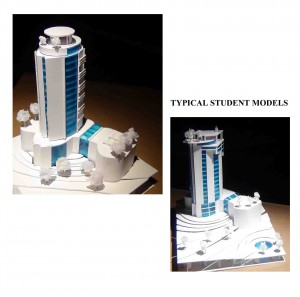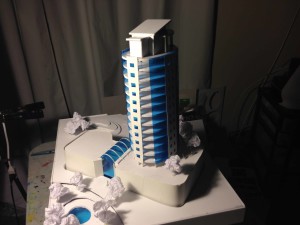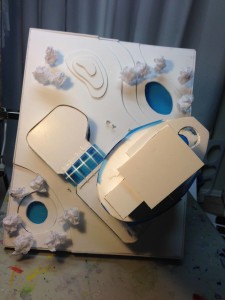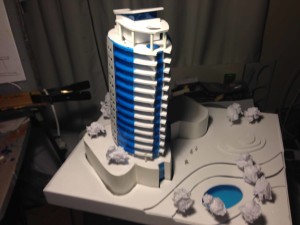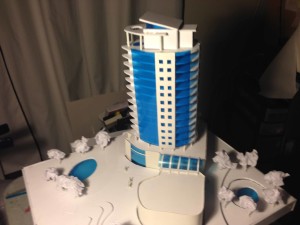Emily Carr course: Building Architectural Models and Maquettes, Fall 2015. foamcore , Bristol board and gluegun. Excellent work Jenna!
Category: ARCHITECTURAL MODEL BUILDING
STEP BY STEPS For Highrise Model Project
This is a “Design Sketch Model”. Buildings designed with a physical sketch-model are different and more sculptural than buildings designed with drawings alone, even those designed with 3d computer programs. Here is the general process for a modelling project I often do with my students. Every student alters and customizes the building design, often radically.We model and draw at the same time. Build it. Fix it. Cut it apart. Change it. It is not a highly finished plastic model. But they do look pretty good in photos. I know other people often prefer aesthetically special materials, eg brown cardboard, archival matte board, white glue, etc. But foamcore, 2 ply bristol board, clear plastic mylar (this I do tint one side with spraycan), and hot gluegun is the most flexible and quick combo for a conceptual model. I prefer to keep everything sculptural and simple and FAST. The result does look good in photos – see some finished student models below.
ORTHO-DOODLE EXERCISE 1 OF 3 (2015)
Login to view this content or Join us and Register.
Please note: Some video tutorials are exclusive to students currently enrolled in courses at Emily Carr. If you are already logged in but you cannot access this content, if may be because you do not have the required membership level. Please contact Tony if you are interested in a course.
ORTHO-DOODLE EXERCISE 2 OF 3 (2015)
Login to view this content or Join us and Register.
Please note: Some video tutorials are exclusive to students currently enrolled in courses at Emily Carr. If you are already logged in but you cannot access this content, if may be because you do not have the required membership level. Please contact Tony if you are interested in a course.
ORTHO-DOODLE EXERCISE 3 OF 3 (2015)
Login to view this content or Join us and Register.
Please note: Some video tutorials are exclusive to students currently enrolled in courses at Emily Carr. If you are already logged in but you cannot access this content, if may be because you do not have the required membership level. Please contact Tony if you are interested in a course.
Accepted Carleton Architecture! Congrats…(click title)
http://issuu.com/guillermobourget/docs/guillermobourgetportfolio
(If you follow this link you will find many examples of architecture and other portfolios.)
Hello Tony, This is Guillermo. I was enrolled in 3 of your courses at Emily Carr in the fall term, I would like to thank you for helping me develop my skills in architecture. I received my letter of acceptance from Carleton University School of Architecture. For the last months I developed a Portfolio in which I included some art pieces we did in the classroom. I also included the model of the 15 story building we made in the modeling class, (well I made it at my home, but I couldnt have completed it without your guidance). Your website is fabulous it helped me out a lot to create an idea of what a portfolio should look like. I would be pleased if you take a look at mine at this link. If you have any ideas on how I can improve it please let me know. I would appreciate it a lot! I would be pleased if you put it up in your website, thank you again! Guillermo
– Congrats Guillermo, I am very happy you were successful getting into Architecture At Carleton. Looking at your portfolio, I honestly would not change anything. It looks casual, but organized. That’s the perfect message for a school audience. “Too clever is dumb.” Your highrise looks good and shows you can do 3D stuff. Perfect. Congratulations and best of luck. Stay in touch and give me your impressions of the school after your beginning year is over. You are justifiably proud of your work and your acceptance…Tony O’
SKETCH-MODEL EXAMPLE
Learn to do this in my Emily Carr course on “Building Architectural Models and Maquetttes”. This is a typical model built by one of my students. It took about 20-24 hours of work with hot gluegun and foamcore. It is a ‘design sketch model’ in that the purpose is to be able to build-change-rebuild during the design process. Generally, buildings designed with 3d modelbuilding supplementing the process are richer in terms of form. It can look quite finished if photographed carefully, but the main purpose is for design.
ACCEPTED TO UBC ARCHITECTURE SCHOOL! (Click title – link to portfolio below)
Congrats on your acceptance! (I just got this note from a recent student today. Jordan took several of my architecture related model-building, design, and drawing courses, all represented in his portfolio) :
Hey Tony! I found out today that I was accepted into the UBC architecture program for this coming Fall. I could not have done it without your help and guidance, and I look forward to joining you in some more classes this summer. I’ll attach my portfolio to this email in case you want to use it as an example on your website. All the best, Jordan
